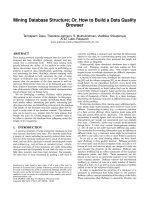How to Display Data- P22 ppsx
Bạn đang xem bản rút gọn của tài liệu. Xem và tải ngay bản đầy đủ của tài liệu tại đây (188.96 KB, 5 trang )
Time series plots and survival curves 97
5 Pocock SJ, Clayton TC, Altman DG. Survival plots of time-to-event outcomes in
clinical trials: good practice and pitfalls. Lancet 2002;359:1686–9.
6 Morrell CJ, Walters SJ, Dixon S, Collins K, Brereton LML, Peters J, et al. Cost effec-
tiveness of community leg ulcer clinic: randomised controlled trial. British Medical
Journal 1998;316:1487–91.
98
Chapter 9 Displaying results
in presentations
9.1 Introduction
The principle aim of any research presentation or paper is to communicate
the results of a study. An important aspect of this is to have an awareness
of the intended audience and format available for conveying the relevant
information. Whilst the main principle involved when displaying results
in either presentations or papers is similar – above all else keep it simple –
different formats lend themselves to different types of display, and what is
appropriate for a paper or poster may not be appropriate for a presenta-
tion. This chapter will focus on how to present information to an audience
as part of a seminar or presentation, including how to design good quality,
readable slides. These, as much as the person presenting, can make or break
a presentation. How to present results in papers has been covered in previ-
ous chapters.
When giving an oral presentation to an audience there are several points
to be considered. It is important to have an awareness of who the audience
are; what information is to be presented and how this information is to be
delivered. An integral part of presenting information verbally is having a set
of well-designed slides containing information appropriate to the audience.
Well-designed slides and good visuals can be enormously useful and greatly
enhance a presentation, whilst poorly designed slides with inappropriate
visuals can spoil an otherwise informative presentation. Much of this sec-
tion will be concerned with good slide design, as this is an area that is of
fundamental importance when communicating information to an audience:
there is little use having good quality tables and charts if the slides them-
selves are badly designed and diffi cult to read.
Often presentations, particularly at a conference or seminar have to be
given in a limited amount of time and much information has to be con-
veyed to the audience in that time. Slides should be used to illustrate key
points, and should not be read out aloud. As it is possible to elucidate key
points verbally in a presentation, there is less need for explanatory text in
Displaying results in presentations 99
slides and they should not appear crowded. It is important to think like
someone in the audience and to consider what it is that the audience will be
seeing and hearing. Charts can be particularly useful as part of a presenta-
tion as they can be read quickly, and the key points can be highlighted more
easily than if a table were used.
9.2 Graphic design of slides
This section will cover the four basic elements of graphic design as they
relate to slide design: text, pictures and graphics, colour, and space.
Designing layouts that involve text, pictures, colour and space is not an
exact science and there are no hard and fast rules, as what works in one situ-
ation will not work in another. Design is about manipulating these four ele-
ments. They are all related and it is almost impossible to alter one without
it impacting on at least one of the others. For example, the size of the text
employed will affect the amount of space available on the slide. However,
the following sections will provide some basic guidance to ensure that your
slides are legible, understandable and enhance your presentation.
It is important to keep the style of the slides, including the text, colour
and any graphic effects consistent throughout a presentation. The choice
of font style and graphics can help with the image that you want to por-
tray. The overall look of your slides and the font style and graphics choices
are part of the image/impression that you want to convey – be smart in
your choices and avoid overly fl ashy styles. These will distract from your
message.
9.3 Text
There is much to consider when thinking about the text used for slides. An
initial question concerns the typeface. At their most fundamental, typefaces
can be divided into two styles, serif and sans serif typefaces and different ones
can be used to create different impressions. Serif typefaces are those with
structural details at the end of each stroke. The most commonly used exam-
ples are Times New Roman and Garamond (Table 9.1). Whilst Times New
Roman is highly legible on paper, it can be diffi cult for an audience to read
on presentation slides and, in general, serif typefaces, particularly the more
ornate ones such as Monotype Corsiva, should be avoided for presentations.
Sans serif typefaces (from the French ‘sans’ meaning ‘without’) do not have
fl ourishes at the end of each letter and common examples include Arial and
Verdana (Table 9.1). Sans serif typefaces are easier for an audience to read and
should be used for the text on slides. Text is always meant to be read and so
100 How to Display Data
when considering text on slides it is important to bear this principle of leg-
ibility in mind Figure 9.1 shows an example of a slide which is overcrowded.
Table 9.1 Examples of common typefaces
Examples of common serif typefaces Examples of common sans serif typefaces
Times New Roman Arial
Garamond Verdana
Book Antiqua Comic Sans MS
No more than two fonts should be used on any slide and text should not
take up more than half the visible area. As a good rule of thumb slides should
be limited to about six lines of text and no more than six words per line. If
this makes it diffi cult to fi t all the points onto a single slide then it is best to
break up the points and use more than one slide Figure 9.2 shows how the
slide in Figure 9.1 could be split into two slides to improve legibility.
A slide with all the text in capital letters is more diffi cult to read than a
mixture of upper and lower case letters and capitals should only be used for
Figure 9.1 Example of over-crowded slide.
What do we mean when we talk about bivariate data?
• Data where there are two variables
• The two variables can be either categorical, or numerical
• This session we are dealing with continuous bivariate data i.e. both
variables are continuous
• We have also looked at categorical bivariate data …
Number who die from
rhabdomyolysis
Number alive or died from
other causes
21
Baycol
Other
statins
Total 1,000,000 10,000,000
999,998 9,999,999
• There are two binary (categorical) variables
– Type of stain (Baycol/other)
– Whether died of rhabdomyolysis or not
• From these data we examined the risk of death from
rhabdomyolysis of Baycol compared to other statins
… categorical bivariate data example from Risk lecture
Displaying results in presentations 101
the fi rst character of titles, bullets or names. In general a font size of at least
28 points should be used for the titles and at least 18 points for the main
body of the text. As a rough guide if your slide can be read from a distance
of about 1 m on a 14 in. computer monitor then it will be legible to an audi-
ence when projected (although this will depend upon the size of the room
and the size of the screen it is being projected onto).
Text is best highlighted using spacing, italics or colours since underlined or
bold text is less easy to read when highlighted. Grouping text can be an effective
means of emphasising points and is particularly useful when building up lists
(a)
What do we mean when we talk about bivariate data?
• Data where there are two variables
• The two variables can be either
categorical, or numerical
• This session we are dealing with continuous
bivariate data i.e. both variables
are continuous
• We have also looked at categorical
bivariate data …
Figure 9.2 The same slide split into two separate slides, using a single font type: (a)
part 1 of information in Figure 9.1 and (b) part 2 of information in Figure 9.1.
(b)
… categorical bivariate data
example from Risk lecture
• There are two binary (categorical) variables
– Type of statin (Baycol / other)
– Whether died of rhabdomyolysis or not
• From these data we examined the risk of death from
rhabdomyolysis of Baycol compared to other statins
Number who die from
rhabdomyolysis
Number alive or died from
other causes
21
Baycol Other statins
Total 1,000,000 10,000,000
999,998 9,999,999









